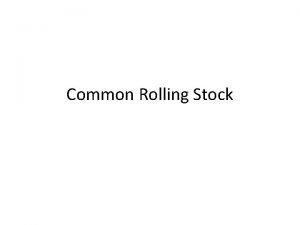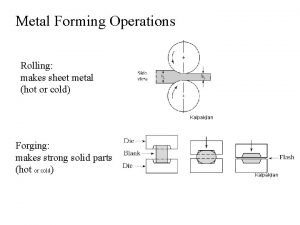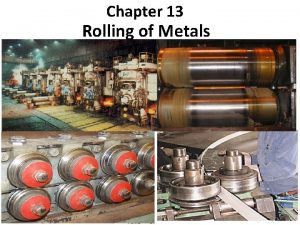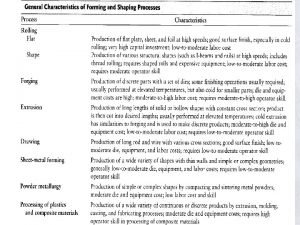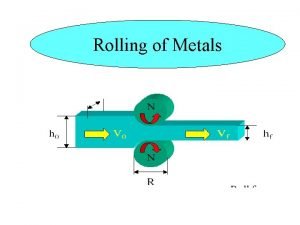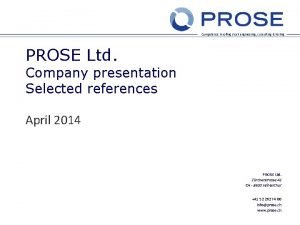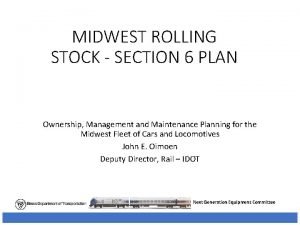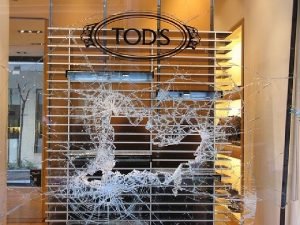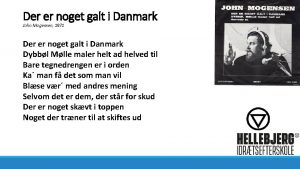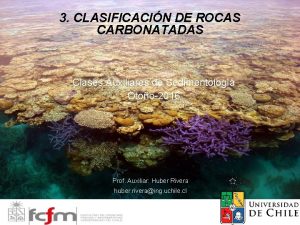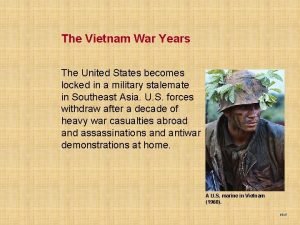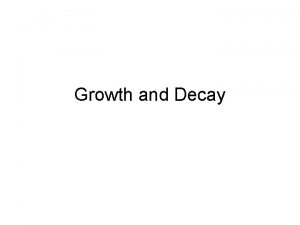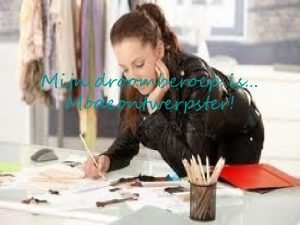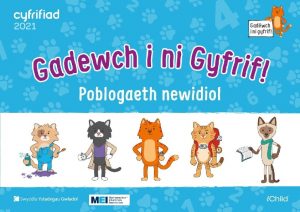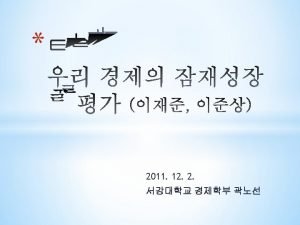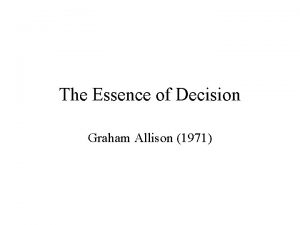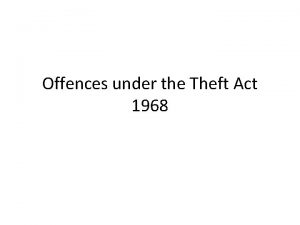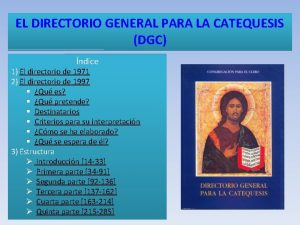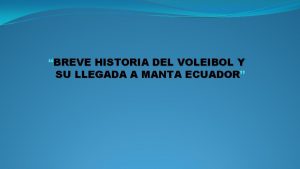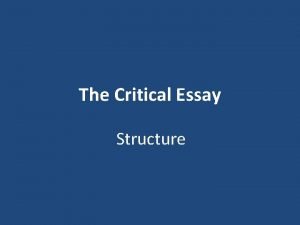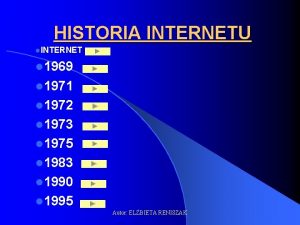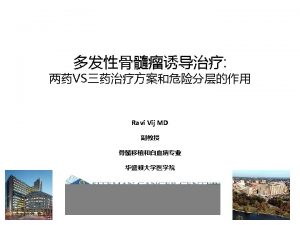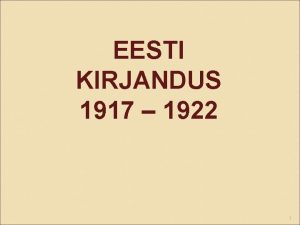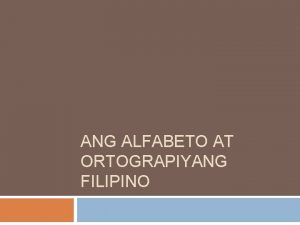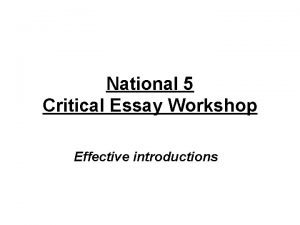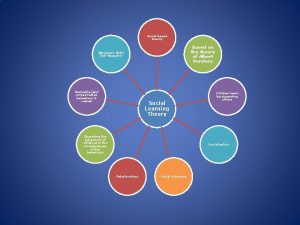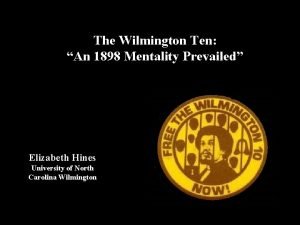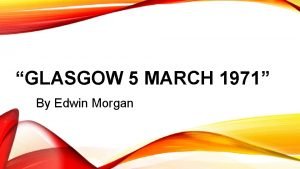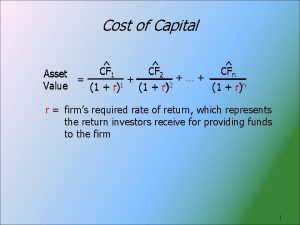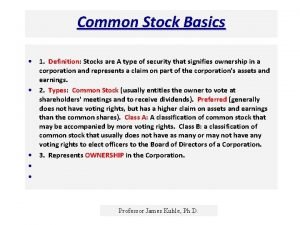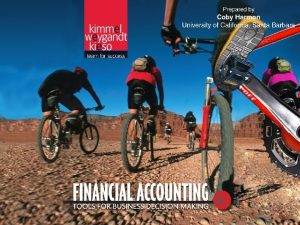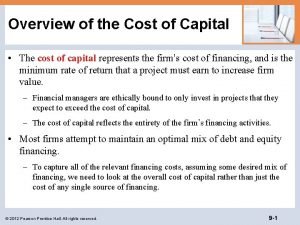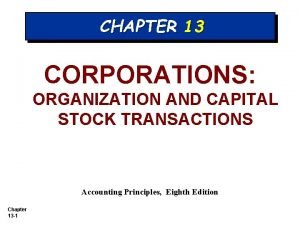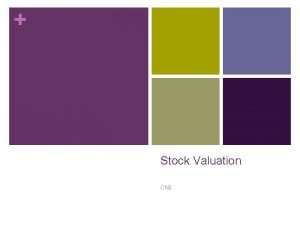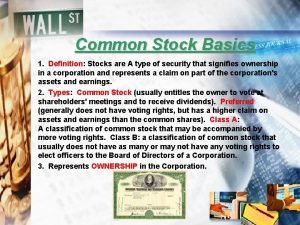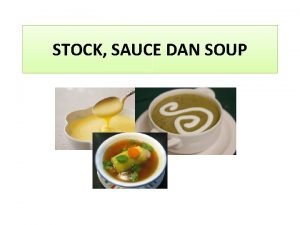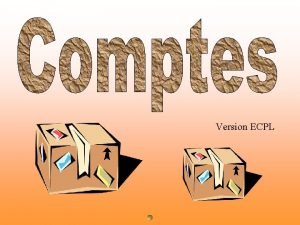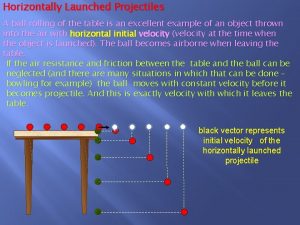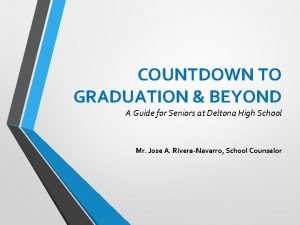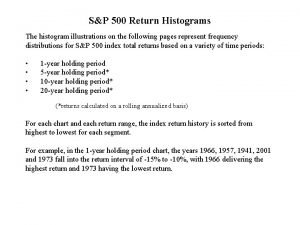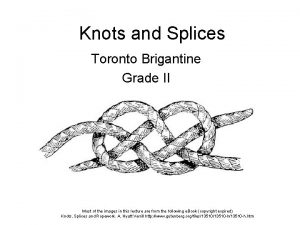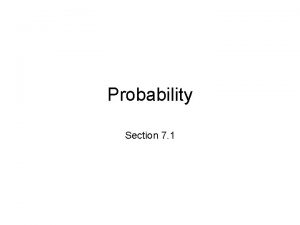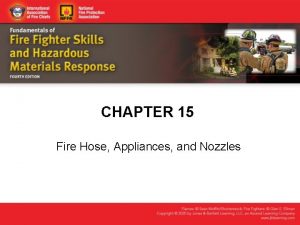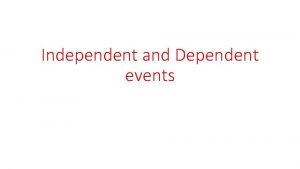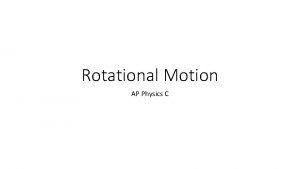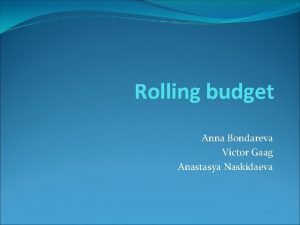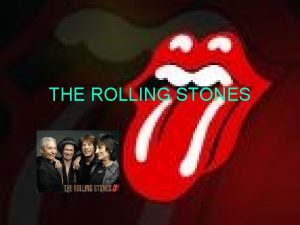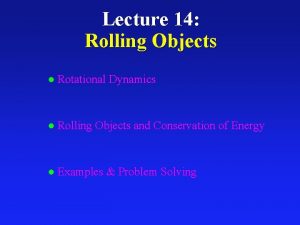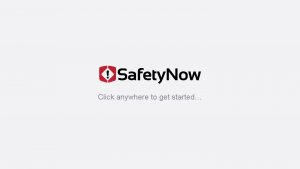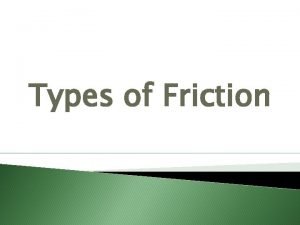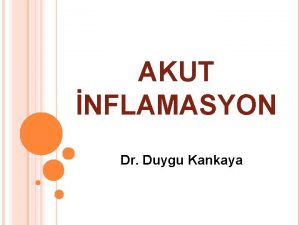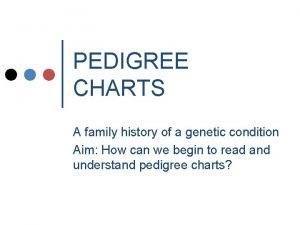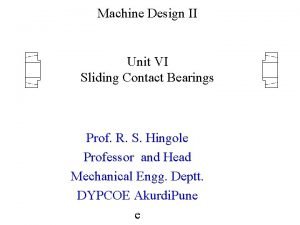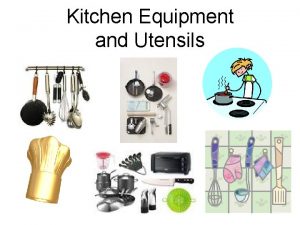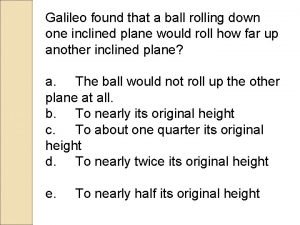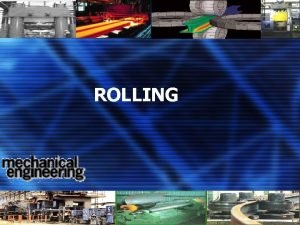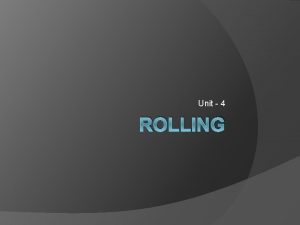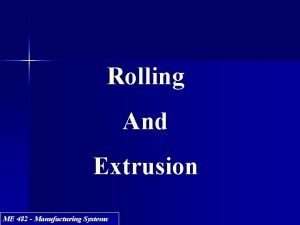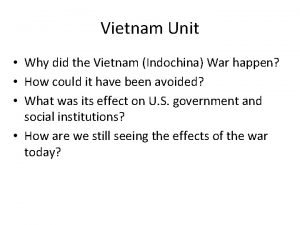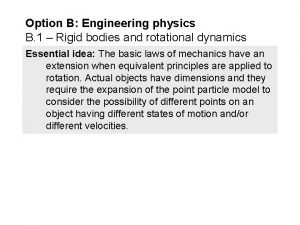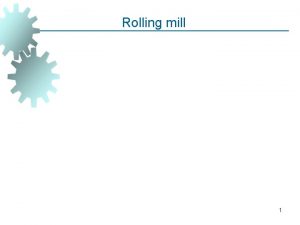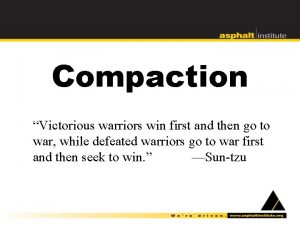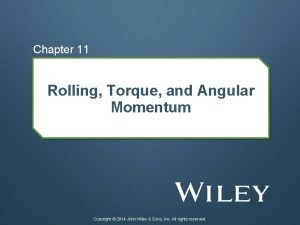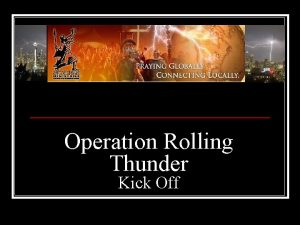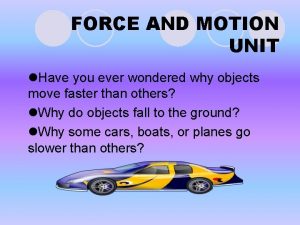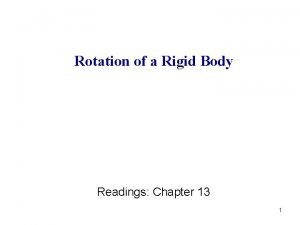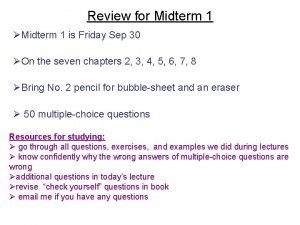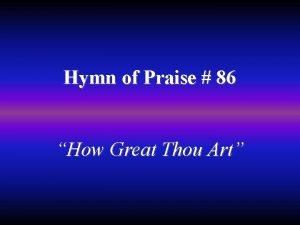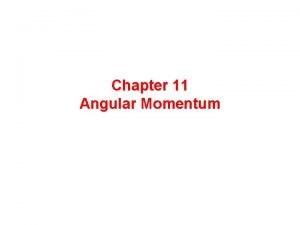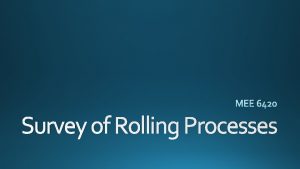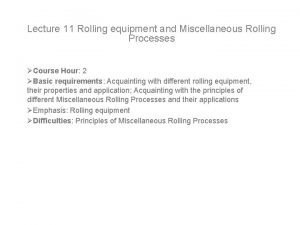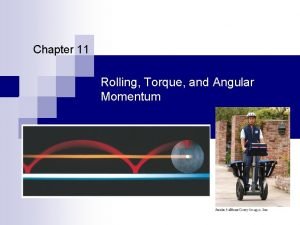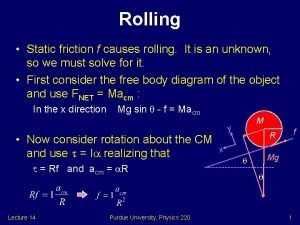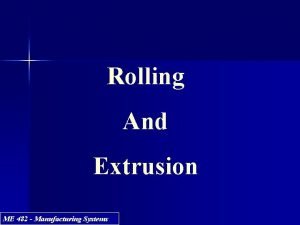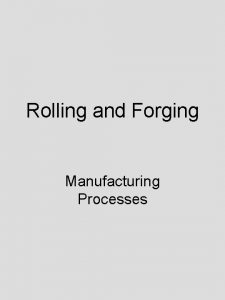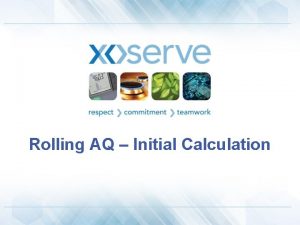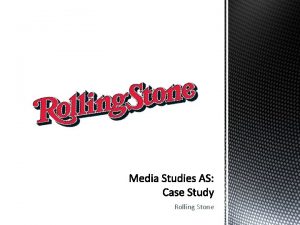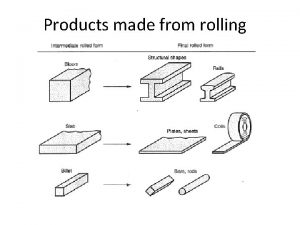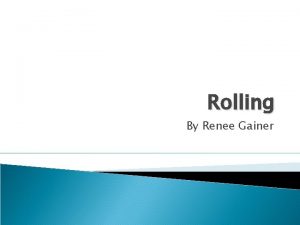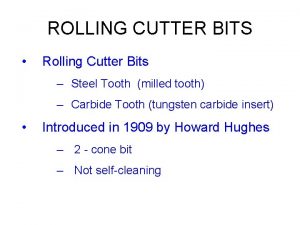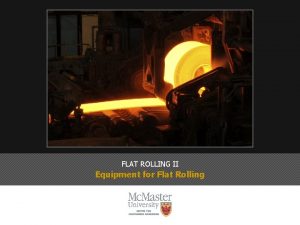Common Rolling Stock Dimensions of Rolling Stock 1971




















































































![• About 1905 of these were obtained first (in two batches) [6/02] and • About 1905 of these were obtained first (in two batches) [6/02] and](https://slidetodoc.com/presentation_image_h/d7122ef8019d668b7143e0afca3cdcd6/image-85.jpg)






- Slides: 91

Common Rolling Stock

Dimensions of Rolling Stock — 1971

How are freight cars classifed by IR? • The following codes are used now for classifying freight cars. The classification scheme is not entirely systematic. Older wagons especially have codes that are not easily explained in this way. But in general an optional gauge code is followed by a type code which is followed by an indication of the coupler and whether the wagon is air-braked. • Gauge code – M : (prefix) MG – N : (prefix) NG

Wagon type code B : (prefix) Bogie wagon (sometimes omitted) BV : Brake van V : Brake/parcel van (see above for brake van codes) O : Open wagon (gondola) C : Covered wagon (boxcar) F : Flat car FK : Flat car for container transport FU : Well wagon LA : Low flat car with standard buffer height LB : Low flat car with low buffer height LAB : Low flat car, one end with low buffers, the other with high buffers – R : Rail-carrying wagon – – –

Wagon type code – – – T : Tanker (additional letters indicate material carried) U : Well wagon W : Well wagon K : Open wagon: ballast / material / refuse transport (older wagons) C : Centre discharge S : Side discharge R : Rapid (forced) discharge, bottom discharge X : Both centre and side discharge X : (also? ) High sided Y : Low (medium? ) side walls L : Low sided H : Heavy load

The ‘B’ indication is sometimes omitted as all new wagons are bogie stock. • Following the type code in the classification code a letter may denote the type of coupler, nowadays optional, as all new freight cars are fitted with centre buffer couplers (CBC). An 'N' suffix is for 'pneumatic', or air-braked wagons. Most newer stock that is air-braked also has CBC couplers, so the 'C' is usually dropped. E. g. , BOXN for air-braked BOX wagons, not BOXCN. Almost all the older stock is vacuumbraked.

The ‘B’ indication is sometimes omitted as all new wagons are bogie stock. • Coupler, brake, and other suffixes: – C = Centre buffer coupler (CBC) – R = Screw coupling only – T = Transition coupler (CBC with additional side buffers and screw coupling) – N = Air-braked – M = (suffix) Military

stainless steel or special steel alloys to reduce corrosion in wagons • Most wagons are made of steel, except for a few special-purpose wagons. Some specialized wagons have been made with stainless steel or special steel alloys to reduce corrosion. Some Recently [12/04] with the rising price of steel IR has been looking into using steel substitutes, and plans have also been drawn up for the production of aluminium-body wagons (see BOBNAL, BOBRAL below).

Aluminium wagons • The tare weight is expected to be reduced by about 4. 2 tonnes. A few aluminium wagons are already in use on a trial basis. Aluminium wagons besides being of a lower cost and having a lower tare weight, also have the advantage of suffering less corrosion in many circumstances. A typical rake with aluminium wagons instead of steel ones would carry almost 240 t more goods.

Axle load • As seen in the permanent way section, many BG routes have rails that allow axle loads of up to 25 t, or in many cases 22. 5 t. However, normal operating procedures on IR restrict BG wagons to 20. 3 t of axle load. It has been proposed that this be raised to 23 t.

Box Wagon • High-sided bogie open wagon. Side discharge arrangement. 55 ton capacity, 25 ton tare. Used for coal and other bulk goods. About 7, 000 of these are in use [2006]; this class is in decline since the advent of the BOXN and other variants. There used to be over 14, 000 of these in the 1990 s, and about 8, 800 as late as 2005. BOXT, BOXR, and BOXC are the same with transition, screw, and CBC couplers, respectively.

BOXN Wagon • • • BOX variant: High-sided bogie open wagon with Pneumatic brakes, High tensile CBC couplers, CASNUB cast steel bogies, Cartridge tapered roller bearings. Perhaps the most common wagon, there around 64, 000 or more of these in use [20022006]. Used for bulk movement of material commodities (coal, iron ore, stone, etc. ).


BOXN Features

BOXN

BOXN-HA • The BOXNHA type is a BOXN variant with improved bogies and higher capacity, fit for 100 km/h. (Suffix 'HA' = 'high axle load'. ) Uses IRF 108 HS cast steel bogies with secondary suspension, CBC couplers, and singlepipe air brakes. The wagon is similar to the BOXN wagon in length and width, but taller by 225 mm. Rake loads rise to 3783 t from the 3411 t of ordinary BOXN wagons. • These wagons were designed for higher speed (100 km/h) operations with higher axle loads (22. 1 t for coal, 23. 5 t for iron ore).

BOXN-HA • this section could not handle the higher axle loads (the wagons required 52 kg 90 UTS rails) and upgrade plans were dropped, so the decision was made to run the BOXN-HA wagons with reduced loading and stop the manufacture of more of them. About 400 more of them were eventually manufactured before production was halted permanently.

BOXN-HA • RDSO later developed the BOXN-HS variants (see below) which later became more widely used for high-speed iron ore and coal loads. BOXN-HA production has not resumed although now many main line sections have 60 kg rails and are quite capable of handling the wagons' higher axle loads. It appears that the poor condition of some bridges and other track structures may have been the reason behind halting the BOXN-HA production. Had this wagon come into general use, freight rakes of 5220 tonnes could have been run. These wagons number about 731 as of 2006.

BOXN-HA

BOXN-HS • BOXNHS wagons are converted BOXN wagons fitted with CASNUB HS high-speed bogies raising the max. speed to 100 km/h. Developed by RDSO after the BOXN-HA wagons didn't work out; it has a 8% lower capacity compared to the BOXN-HA. Many BOXN-HS wagons have been seen [8/05] with a name, 'Pragati', stenciled on them. It is not known whether these represent some sort of class name or a variant design.

BOXN-HS

BOXN-HL • BOXNHL wagons are like BOXNHS wagons but about 250 mm longer, and made of stainless steel and cold rolled sections. Air-braked, CBC couplers, roller bearings.

BOXN-HL

BOXN-CR • BOXNCR wagons are corrosion-resistant BOXN wagons built with 3 CR 12 stainless steel (a proprietary version of grade 409 stainless steel). Only about 580 of these (10 rakes) have been built so far [4/02] as part of ongoing service trials. Note: In 2006, IR's published statistics reported holdings of only 286 of these wagons; it's not clear whether this is a clerical error or whether nearly 300 of them have been retired/scrapped in recent years.

BOXN-LW • The BOXNLW wagons are low-tare-weight BOXN wagons ('LW' = 'low weight') The tare weight is reduced by 1. 8 t compared to BOXN wagons, and the payload correspondingly increased by the same amount. This wagon has a stainless steel body to reduce corrosion. About 250 of these (4 rakes) have been bult so far [12/04] as part of ongoing service trials Airbraked, CBC coupler, roller bearings. .

BOXN-LW

BOXN-AL • BOXNAL wagons are BOXN wagons with an aluminium body on top of a steel underframe. The aluminium alloy is 'RDE-40', also used in the BOBR-AL wagons. These wagons are naturally lighter and allow a higher payload to be carried for the same axle load.

BOXN-EL • The BOXNEL wagons are BOXN wagons with 'enhanced loading' features, designed for transporting coal, ores, etc. CASNUB 22 NLC bogies, CBC couplers, single-pipe air brakes.

BOXN-EL

BOXN-EL

• BOXN-25 M • BOXN variants produced by Golden Rock Workshops (2012) designed for a 25 t axle load and correspondingly higher carrying capacity. Swing motion bogies. • BOXES • BOX wagon with side discharge / flap doors, siding roof (rare)

BCN • Bogie covered 8 -wheeler wagon, CASNUB bogies, air-braked, CBC. Originally developed in 1984 for carrying bagged commodities. Original model had entirely riveted construction. This variant has undergone some changes over the years. Newer ones have snubbers and nested coil springs under bolster, elastomeric pads, with secondary suspension system.

BCN

BCNA

BCNA • The BCNA wagon, also known as 'BCN/A', is a variant of the BCN design was developed to be less long but increased height to keep the capacity the same. It has welded construction compared to the original BCN which was riveted. BCNA wagons are covered bogie wagons (capable of being made water-tight for delicate commodities) with cartridge tapered roller bearings, cast steel bogie, air brakes. Two doors on each side.

BCNA • Uses BCN design's 2 -tonne overload capacity. Also very common, there are more than 42, 000 of these in use [2006]. Used for foodstuffs, cement, etc. (but see the BCCN wagon below, especially for cement transport, and BCX, which are also used for bulk food transport).

BCNA

BCNA

BCNA-HS

BCNA-HS • BCNAHS wagons are a modified design of the BCNA wagons with CASNUB HS high-speed bogies raising the max. speed to 100 km/h. These wagons are characterised by a patch of red/white horizontal stripes on the top left.

• BCN variants for carrying bulk cement. Loading is through ports at the top; unloading via chutes at the bottom.

BCCN/BCCNA/BCCNB Automobile Carriers • A few wagons also marked BCCN like the cement carrier class noted above are actually single- or double-decker wagons intended for carrying automobiles; these have a low platform with 840 mm wheel diameter and are fitted with air brakes. Only about 50 of these are thought to exist [4/02]. The explanation of the class code is that they are thought to have been made by taking old BCCN wagons and modifying them.

BCCN • They were built in 1997 by the Golden Rock Workshops based on designs from RDSO, and were intended to carry Maruti brand automobiles. These come in two varieties, 'A', and 'B', classified BCCNA and BCCNB. More recently [11/04] another variation, BCCNR (BCCN-R), has been spotted - see separate entry below.

BCCNR • Automobile carrier wagons introduced in 2004. these are single-deck covered wagons with 10 t capacity and 28. 5 t tare weight, and a low platform with 840 mm diameter wheels. Some of these were limited to 65 km/h but later were apparently approved for 100 km/h. These were designed to capture more automobile traffic, especially from the south

BCCNR • The introduction of different car models by various manufacturers in recent years which could not be carried on the original wagons (taller and bigger cars can now be carried). These were built starting in 2000 after some trials of in early 1999 of several variant designs proposed by RDSO. BCCNR wagons are not thought to number more than about 35.

NMG (New maruti goods) • These are not narrow-gauge wagons, despite the classification code! These are usually single-decker automobile carriers constructed out of old ICF and BEML passenger stock. The design is not entirely uniform but generally all the windows and doors are welded shut, and a new end door created to allow vehicles to be driven into the wagon.

NMG (New maruti goods) • Some NMG wagons are made from old double -decker passenger stock and are thought to allow double-deck carrying of automobiles. A few NMG units converted from old BCCN (cement wagons) have also been spotted. The class code 'NMG' stands for 'New Modified Goods'; but at the time of its introduction it was also common to hear the explanation that it stood for 'New Maruti Goods' (Maruti is an Indian car manufacturer).


Other Automobile Carriers • Several other converted coaches have been used for carrying automobiles. CONCOR has recently [1/05] announced plans for a 'CARTRAC' service to carry automobiles. This appears to use the old coaches from rakes of trains like the Gujarat Exp. , formerly vacuum-braked, modified by welding the side doors shut and adding openings at the ends to load cars. A movable ramp guides cars into one of two decks and then folds away when the wagon is in motion.

BCX • Water-tight covered high-sided bogie wagon with cast steel bogies. Cartridge taper bearings on newer ones. Snubbers and nested coil springs under bolster, elastomeric pads, with secondary suspension system. Used for foodgrains, cement, etc. (BCXT, BCXR, BCXC are variants with transition couplers, screw couplers, and CBC) Around 18, 000 of these are in use. CASNUB cast steel bogies. There are over 7, 700 of these [2006]. The class is in decline - there were 9, 200 of these in 2004.

BCX

• BOY • Low-sided bogie open wagon, CBC 91. 4 tonne load. Used for iron ore transport, etc. There about 880 of these [2006]; the class is somewhat in decline - there were over 900 of these in the late 1990 s. • BOY-EL • BOYEL wagons are low-sided bogie open wagons a BOY variant for 'enhanced loading'. Designed for transporting coal, ores, etc. CASNUB 22 NLC bogies, CBC couplers, single-pipe air brakes.

BOY-EL

BOBS • Open hopper car with bottom/side discharge (often used for ballast and ores) Similar to the BOBR/BOBRN wagons, except that the discharge is to the side (clear of the tracks). Underside doors on the wagons are operated pneumatically, and can be controlled by a lineside triggering mechanism. The various 'BOB' variants together number about 1, 500 wagons.

BOBS-NM 1 • Open hopper car with bottom/side discharge, variant of BOBS with different suspension and allowing a higher axle load of 25 t. Used for ballast and ore transport. Several BOBS wagons were converted to BOBS-NM 1 in 2006 -2007.

BOBS-NM 1

BOBYN • Open hopper car with side-bottom discharge, for carrying stone, track ballast, etc. These are air-braked.

BOBYN

BOBYN

• BOBC • Open hopper car with bottom/centre discharge • BOBX • Open hopper car with bottom/side and bottom/centre discharge • BOBR • Open hopper car with rapid (pneumatic) bottom discharge doors. Same as BOBRN (see below) except that they have vacuum brakes and are rated for lower speeds (80 km/h? ).

BOBRN

BOBRN • Open hopper car with rapid (pneumatic) bottom discharge doors, air-braked. BOBRN and BOBR (see above) are most often used for carrying coal to thermal power plants, and also for ore, stone, track ballast, etc. Each wagon holds some 60 t of coal loaded from the top and unloaded from the bottom by means of the pneumatically operated doors. The contents of the wagon can be discharged completely in about 15 seconds.

BOBRN • The door-opening mechanism is triggered by lineside devices running on a 24 V or 32 V DC source. As the wagons in a rake pass by the triggering devices, their doors open and their contents are unloaded into the pits below the tracks (the 'merry-go-round' system). The versions used by the power plants have 12 bottom doors, whereas IR uses variants that have 8 doors.

BOBRN

BOBRN

BFK Early version container flat car BKFX Container flat car for domestic 5 -ton containers. Improved BFK with CASNUB bogies (not much used now with the move to standard containers). • BFKI • Container flat car for ISO containers, with retractable anchor locks. Originally fitted with vacuum brakes. CONCOR bought about 1300 of these from IR in 19971998 and retrofitted them with air-brakes and put them to use on its domestic container traffic routes ('Contrack'). The ones fitted with air-brakes were generally reclassified 'BFKN' (see below). In all, there about 1, 571 of these now [2006]. • •

• BFKN • Converted BFKI flat cars with air brakes and CASNUB bogies. See 'BFKI' above. • ? ? ? • (Code not known) Special flat wagon. • Tare 30 t, payload 90 t. Length 11. 93 m, width of carbody 2. 8 m, height 1. 49 m. AAR 'NT' CBC. UIC bogies. No continuous brakes, parking brakes only. Rated at 25 km/h. • BFNS • Special flat wagons for transport of steel (coils, sheets, etc. ) and also used for transporting rails. Air-braked. CASNUB 22 NLB bogies. Max. speed 100 km/h.

BFNS

• 'Crop' wagon for steel plants. Flat platform for finished steel goods, with low sidewalls. • Tare 25 t, payload 55 t. Length 8. 33 m, width of carbody 2. 66 m, height 2. 19 m. Screw coupling, no continous brakes (only parking brake). Diamond frame bogies. Limited to 25 km/h. • BFR Bogie flat rail-carrying wagon (64 tonne load) • BFU Bogie flat type wagon : for transporting motor vehicles. • BOM Bogie open military wagon.

BRH • Bogie rail-carrying flat car with roller bearings. This has end-plates that can be removed.

BRHT • • Bogie rail wagon, Heavy load (80 tonne load), UIC bogies, Transition coupler

BRN • Developed in 1994 as an improvement on the older BRH wagon. Air-braked wagon with CASNUB bogies, for rails and steel products and similar heavy loads. These were originally built with 58 t capacity, but around 2, 200 of them are being downgraded [10/02] to 48 t capacity. BRNA-HS is the high-speed version of these.


BTP, BTPN • The most common bogie tanker wagon seen today. Used primarily for liquid petroleum products (petrol, naphtha, kerosene, diesel, furnace oil, etc. ), and also for molasses, vegetable oil, etc. An enhanced version, the BTFLN, has been developed recently (see below). The payload to tare ratio for this tanker is 2. 0. There about 7, 300 of these [2006]


BTPN

BTPGLN Bogie tanker, for liquefied petroleum gas (LPG).

BTPGLN

BVG, BVGT, MBVG, NBVG • Brake van for non-block rakes. BGVT is the same with a transition coupler. MBVG is the MG version and NBVG is the NG version. 4 wheeled.

Milk tanker • These are special tankers for carrying milk at 4 degrees Celsius. The milk is carried in an inner barrel of stainless steel, surrounded by an outer barrel with insulation between the two. Pasteurized and chilled milk remains cool enough with such an insulated design so that it does not spoil on fairly long journeys; there is no need for refrigeration equipment. These tankers are attached to express trains and are treated on par with passenger stock, and rated for higher speeds (110 km/h) than most freight stock. They have Flexicoil bogies.


• BLAN/BLBN • Bogie low-platform container flats, in mating pairs 'A' and 'B'. These have largely been superseded by the newer designs used by CONCOR (BLCA/BLCB, below). • BLC/BLCA/BLCB • BLC wagons are CONCOR's new [1995] container flats. (Also known as 'CCF', Coaching Container Flats. ) Low platform container flat wagons. These have light-weight welded 'skeletal' design underframes, automatic twist locks, a single-pipe air-brake system, and reduced wheel diameter (for the low beds). The low platform allows them to carry high-cube or Tallboy containers on routes where clearances would otherwise make this impossible.

• These are mostly used for international container traffic from Mumbai. The wagons come in two flavours. An 'A' type (BLCA, also BLC-A) has a normal (AAR 'E' type) CBC at one end a slackless drawbar at the other end. The 'B' type wagon (BLCB, also BLC-B) has only the slackless drawbar couplers at either end. Usually 3, or sometimes 5 BLCB wagons are coupled together, with a BLCA wagon at either end, forming a semipermanently coupled formation of 5 or 7 wagons.

• Being longer than most other wagons, a rake can only have about 45 of these BLC flats, which at the rate of 2 TEU's per wagon works out to a carrying capacity of 90 TEU's per train. A lot of international container traffic (especially from Mumbai) is carried on these. SR's Golden Rock workshops are expected to take over manufacturing these wagons.
![About 1905 of these were obtained first in two batches 602 and • About 1905 of these were obtained first (in two batches) [6/02] and](https://slidetodoc.com/presentation_image_h/d7122ef8019d668b7143e0afca3cdcd6/image-85.jpg)
• About 1905 of these were obtained first (in two batches) [6/02] and a third batch of another 1320 wagons were procured around 2002 -2003. Since then there has been a steady growth in these and now [2006] there about 4, 700 of these in use.


BKH • Bogie open hopper wagon with side and centre discharge (ballast transport)

• BT Hopper cars with bottom discharge, used for departmental rakes carrying ballast • O Open 4 -wheeled wagon • OM, MOM Open military wagon. MOM is the MG version. • TA Tank wagon (acid) • TB Tank wagon (benzene) • TBT Tank wagon (bitumen) • TCL Tank wagon (chlorine) • TCS Tank wagon (caustic soda) • TE Tank wagon (liquid caustic soda) • TF Tank wagon (ammonia) • TG Tank wagon (LPG)

THA Tank wagon (hydrochloric acid) TK Tank wagon (kerosene) TL Tank wagon (heavy oil) TM Tank wagon (molasses) TOH Tank wagon (heavy oil) TORX, MTORX Tank wagon (vegetable oil) and its MG version. • TP, TPR Tank wagon (petroleum), the latter with screw coupling? • TPGLN, TPGLR Tank wagon (petroleum/LPG products), the latter with screw coupling • TR Tank wagon (coal tar) • • •

• • • TSA Tank wagon (sulphuric acid) TV Tank wagon (vegetable oil) TW Tank wagon (water) TX Tank wagon (liquid chlorine) TZ Tank wagon (lubricating oil) TOH Tank wagon (heavy oil, with heating arrangement)

 Bccn wagon
Bccn wagon Long-term debt preferred stock and common stock
Long-term debt preferred stock and common stock Characteristics of common stock
Characteristics of common stock Metal container
Metal container Pack rolling process
Pack rolling process Difference between flat rolling and shape rolling
Difference between flat rolling and shape rolling Rolling
Rolling Hot rolling vs cold rolling
Hot rolling vs cold rolling Rolling stone magazine 1967
Rolling stone magazine 1967 Rolling stock engineering
Rolling stock engineering Rolling stock planning
Rolling stock planning Glasgow 5th march
Glasgow 5th march John mogensen der er noget galt i danmark
John mogensen der er noget galt i danmark Biomicrita
Biomicrita 1971 draft lottery chart
1971 draft lottery chart In 1971 there were 294 105 females
In 1971 there were 294 105 females Droomberoep
Droomberoep Poblogaeth aberystwyth
Poblogaeth aberystwyth 1969 1970 1971 1972 1973 1974 1975 1976 1977 1978
1969 1970 1971 1972 1973 1974 1975 1976 1977 1978 1967 1968 1969 1970 1971 1972 1973 1974 1975 1976
1967 1968 1969 1970 1971 1972 1973 1974 1975 1976 Graham allison models
Graham allison models R v easom 1971
R v easom 1971 Mariana la computadora no (1)
Mariana la computadora no (1) Dgc 2004
Dgc 2004 Historia voleibol resumen
Historia voleibol resumen Glasgow 5 march 1971
Glasgow 5 march 1971 Why do some brains enjoy fear allegra ringo summary
Why do some brains enjoy fear allegra ringo summary Internet 1969
Internet 1969 2006 - 1971
2006 - 1971 Atkinson & shiffrin 1968
Atkinson & shiffrin 1968 Luuletaja 1892-1970
Luuletaja 1892-1970 Modernisasyon ng alpabeto
Modernisasyon ng alpabeto Tart essay introduction
Tart essay introduction Educational implications examples
Educational implications examples Wilmington nc riots 1971
Wilmington nc riots 1971 Glasgow 5 march 1971
Glasgow 5 march 1971 What is the greatest common factor of 12 and 42
What is the greatest common factor of 12 and 42 Find the lcm of 16 24 36 and 54
Find the lcm of 16 24 36 and 54 Common anode and common cathode
Common anode and common cathode Highest common factors and lowest common multiples
Highest common factors and lowest common multiples Factor tree for 72
Factor tree for 72 What are the factors for 54
What are the factors for 54 Capital cf
Capital cf James kuhle
James kuhle Cash flow statement indirect method
Cash flow statement indirect method Cost of debt
Cost of debt Accounting for corporations chapter 13
Accounting for corporations chapter 13 Common stock definition
Common stock definition Dividend growth model formula
Dividend growth model formula Rumus cost of common stock
Rumus cost of common stock Common stock definition
Common stock definition Brown stock adalah
Brown stock adalah Stock initial - stock final
Stock initial - stock final Horizontally launched projectiles
Horizontally launched projectiles University of florida rolling admissions
University of florida rolling admissions Sp annual returns
Sp annual returns Rolling hitch fire service
Rolling hitch fire service What is probability
What is probability Kinds of hose appliances
Kinds of hose appliances Independent events formula
Independent events formula Ap physics c rotational motion frq
Ap physics c rotational motion frq Continuous budget
Continuous budget The rolling stones
The rolling stones Rolling objects examples
Rolling objects examples Click anywhere to start
Click anywhere to start Fluid friction.
Fluid friction. Marjinasyon nedir tıp
Marjinasyon nedir tıp Pedigree chart of rolling tongue
Pedigree chart of rolling tongue Modern database design
Modern database design Rolling stone magazine
Rolling stone magazine Which of the following is sliding contact bearing
Which of the following is sliding contact bearing Tools for mixing blending straining and rolling
Tools for mixing blending straining and rolling Galileo found that a ball rolling down an inclined
Galileo found that a ball rolling down an inclined Rolling stone granite
Rolling stone granite Rolling kerja
Rolling kerja Powder rolling process
Powder rolling process Rolling and extrusion
Rolling and extrusion Operation rolling thunder cold war
Operation rolling thunder cold war Right hand rule dynamics
Right hand rule dynamics Rolling rota
Rolling rota Wavy edges in rolling
Wavy edges in rolling Mamimum gyroscopic couple,
Mamimum gyroscopic couple, Asphalt rolling pattern
Asphalt rolling pattern Rolling torque and angular momentum
Rolling torque and angular momentum Rolling plan for ict standardisation
Rolling plan for ict standardisation Rolling thunder kick
Rolling thunder kick A basketball rolling across a flat floor has what energy
A basketball rolling across a flat floor has what energy Kinetic energy of rolling sphere
Kinetic energy of rolling sphere A large heavy truck and a small baby carriage
A large heavy truck and a small baby carriage Edwards plateau weathering
Edwards plateau weathering Save my soul my savior god to thee
Save my soul my savior god to thee Rolling torque and angular momentum
Rolling torque and angular momentum
